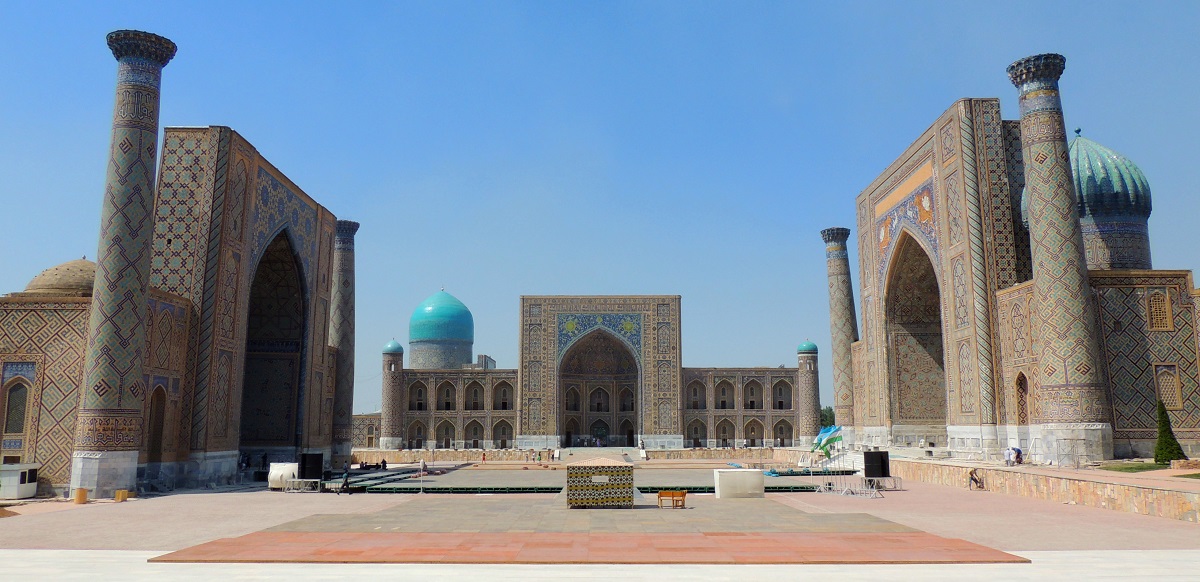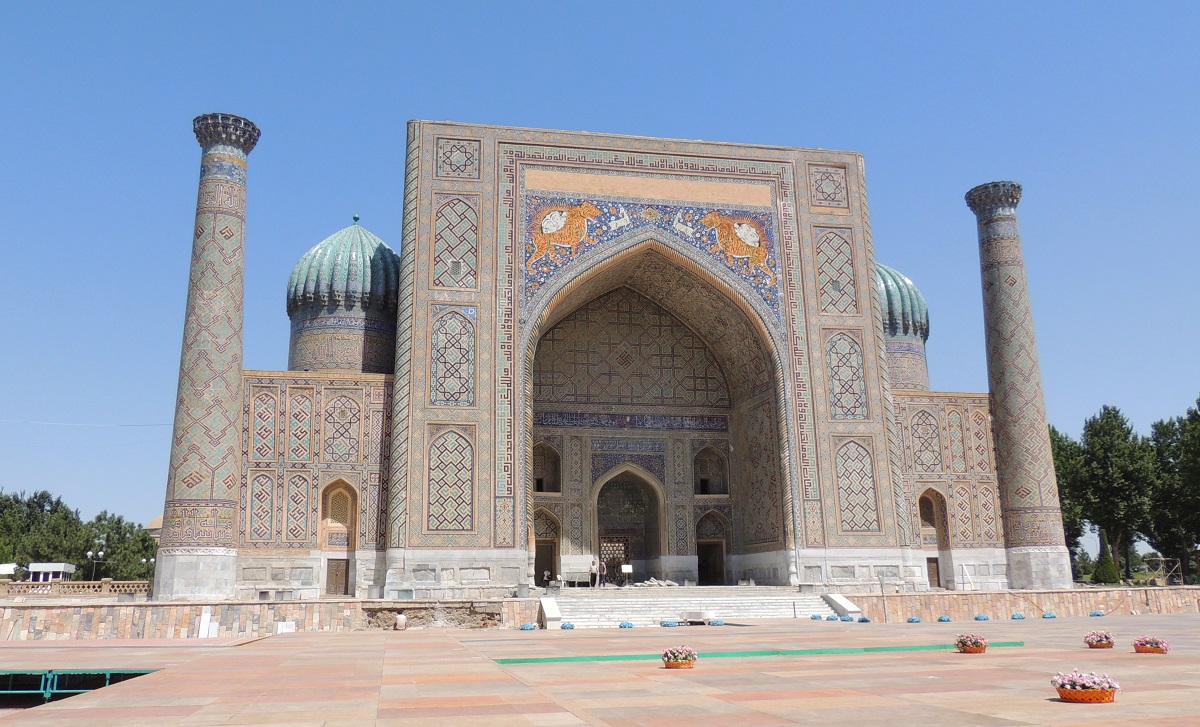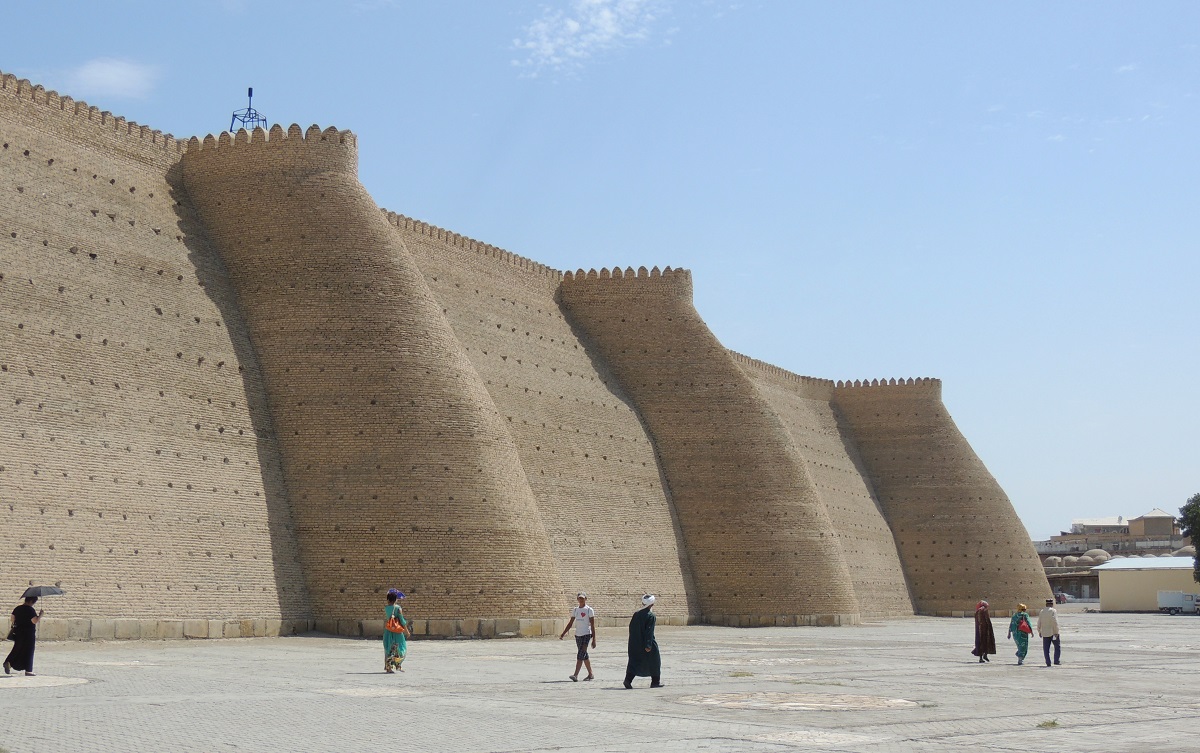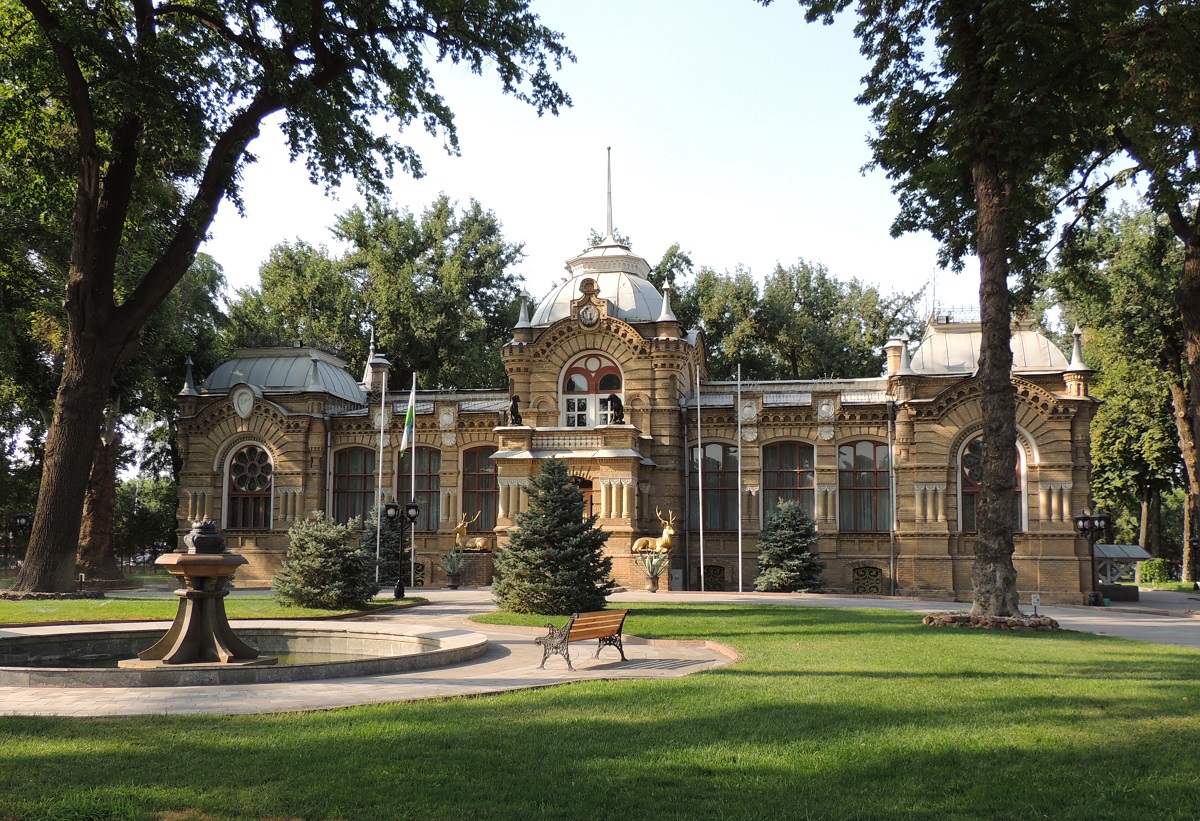The city of Samarkand exudes a great atmosphere taken from the history books about the Silk Road and Amir Timur’s great kingdom. All over the city there are magnificent traces of the ruler’s time in the form of beautiful Islamic style buildings, and some of Central Asia’s finest architecture can be enjoyed in the Uzbek city.
Registan is the centerpiece of the Samarkand that has been inscribed in UNESCO’s World Heritage list for many years. Registan is the most famous place in Uzbekistan and perhaps even throughout Central Asia. Three spectacular madrasas stand around the square, each lavishly decorated with the familiar blue tiles in rich variations in their geometrical patterns.
The Gur-Emir Mausoleum is located close to Registan, and it deserves its place in the history books for its beauty and inspiration for later mausoleums such as Taj Mahal in Indian Agra. It was in Samarkand, this style of architecture developed.
Samarkand is also the place where the historic Afrosiyob was located. It was on a hill at the city, where remains of the old town’s structure with fortresses and walls still can be seen today. There is a museum for Afrosiyob, and both the Biblical Daniel’s tombs and Ulugh Beks Observatory are located in the same area. The observatory was a scientific institution of high caliber in the 1400s.
Samarkand from recent years is positively influenced by the Russian era, which began with the incorporation into the Russian Empire in 1868. In Russian Turkistan, cities were planned and developed according to European models, and you can experience the architecture of this time as well as the one from the Soviet Union.









Founding of Samarkand
The city of Samarkand is one of the oldest cities in Central Asia, and after millennia of human activity in the area, it proved to be an actual settlement from the 6th century BC; maybe the story goes back even further. There is no exact knowledge of the city’s founding, and researchers are constantly discussing new angles and archaeological finds from early Samarkand.
From the 6th century BC there is certainty that there was a well-developed water system for site settlement, which is also believed to be characterized by various artisan crafts. The site was among the easternmost parts of the Persian-administered area for the following centuries, and here, among other things, was a fort.
Alexander the Great
In the year 329 BC Macedonian Alexander the Great reached Samarkand, which he conquered that year. In Greek, the city was called Maracanda, and the Greek influence created after the initial destruction in 329 BC. a time of new development in the city. This meant that Greek building technology partially replaced the otherwise used, and in several other ways, Greek culture influenced the area for centuries after Alexander the Great.
New kingdoms and rulers
In the year 260 Samarkand was conquered by the Sassanids, who were Persian kings, who ruled a large kingdom from Iran in the period 224 to 651. With the Sassanids, the dualistic religion of Manicism came to the area of Samarkand.
In the mid-400s, Samarkand was conquered by the Heftalites, also known as the White Huns. The Heftalites moved south across the Central Asian territory to present-day India and Pakistan, and retained power in Samarkand and the Uzbek until 557, defeated by an alliance between the Sassanids and Western Turkish Khana, which had arisen following a division of the Gktürkur khanat in Central Asia. The Gothic Turks ruled in Samarkand until the early 600s, when the Sassanids defeated their former allies.
However, the Turks came back to power when they won power after Islam entered Iran. They maintained it for a time until Chinese over the Tang Dynasty overcame them. After that event, Samarkand became a protectorate paying tribute to the Tang government. At this time, Samarkand was religiously home to many different religions, which had not been politically crucial.
Muslim invasion
Around the year 710, Muslims conquered Samarkand. It happened with the invasion of the Umayyad Caliphate under the leadership of Qutayba ibn Muslim. With the Muslims, Islam gained momentum, and some converted over the years to the new religion brought by the rulers.
During this time, the first paper mill in the Islamic world was established in Samarkand. This knowledge reportedly came from Chinese prisoners, and after the establishment in Samarkand the technique and production were copied in several other places, and the production eventually reached Europe as well.
In 862, Ismail Samani joined as ruler and he established the Samanid dynasty, which ruled Samarkand to 999 as vassals to the caliph. During the Sami times, Samarkand was further developed as a trading town along the Silk Road between east and west. Samarkand became one of the capital of the Sami people during this time.
With the end of the Samanid dynasty, various Turkish tribes came into power as rulers of Samarkand, and they came to rule the city in the following centuries.
Genghis Khan’s Mongols
Mongol forces under the leadership of Genghis Khan conquered Samarkand in 1220. According to some sources, several killed in the attack; it was they who hid in mosques or the fortifications of the city. At the conquest, Samarkand was also plundered, and thousands were enrolled in the Mongol army.
Another Mongol attack hit Samarkand, who was badly hit after these two looting. However, the city came back so much that Marco Polo in his descriptions noted that Samarkand was a large and distinguished city.
The Mongols’ control of Samarkand continued until the mid-1300s, when rulers were at the forefront of the city’s development, no longer a victim of the looting of the leaders. The government retained power until 1365, when a rebellion started in Samarkand.
Amir Timur and the Timurid Dynasty
From 1370 Timur established the Timurid Empire, which he expanded greatly from his capital, Samarkand. Timur won one campaign after another, and everywhere in the great kingdom there were skilled artists and craftsmen who went to Samarkand, which Amir Timur’s time came to make a significant building mark.
Timur continually developed the art and saved many artists’ lives so that they could make his capital more beautiful and impressive. Timur himself had visions for the buildings, which many times set new standards for the construction of the time. Among other things, Amir Timur was behind what was then the world’s largest mosque; it still stands like many other buildings from the time of Timur.
After the time of Amir Timur, who stopped his death in 1405, subsequently came from the same dynasty, and not many years passed before the scientist and the later king, Ulugh Bek, developed Samarkand and the kingdom. This happened with a focus on science and science, and among the visible holdings of Ulugh Bek was the establishment of an observatory in Samarkand and three mattresses in Samarkand, Gijduvan and Bukhara respectively.
Uzbek Shaybanids
From 1500, the nomadic Uzbek Shaybanids came to power in Samarkand, and they continuously conquered power in a larger area. After a few years they moved the capital from Samarkand to Bukhara, which of course stopped some of the development in Samarkand.
The downturn marked Samarkand, and over the following centuries various dynasties came to power in Bukhara, which as part of their territory also controlled Samarkand.
The Russian Empire
Konstantin von Kaufman entered Samarkand in 1868 for the growing Russian empire, which from Orenburg looked south to the Central Asian steppes that provided new trade opportunities.
Von Kaufman occupied the citadel of Samarkand, but with his 500 men, his soon-to-be self was besieged in the same place. This happened, among other things, by the emir of Bukhara’s rebellious son, Abdul Malik Tura, who, however, had to see himself beaten considerably by the Russian forces.
Von Kaufman became military general governor of Samarkand, which shortly after the Russian takeover, developed strongly with a new city plan according to Russian pattern and the construction of countless new institutions, churches and other things that belonged to the former Russia. The new city sprang up southwest of Samarkand’s old town, and colonial buildings of that time still dominate many places in the street scene in the area.
In 1886, Samarkand became the capital of the newly established Samarkand Oblast, and continued to advance rapidly with the railroad reaching the city in 1888; it was with the Transcaspic Railway, which connected Samarkand with Krasnovodsk, the present Turkmenbashi in Turkmenistan.
The following decades continued the development of the city, which via Tashkent was linked to European Russia by rail in 1906.
The Soviet era
The Russian revolution in 1917 also included Uzbekistan. Initially, Russian Turkistan was established as a Soviet Republic named Turkistan’s Autonomous Soviet Socialist Republic. However, it had come to battle in the swells of the Russian Revolution. Bolsheviks had established Turkestan Soviet, while not least a Muslim council met in the city of Kokand and tried to establish Turkestan Autonomous Republic as a competitor to communist Turkistan. The fighting between the two groups continued until the 1920s with the Bolsheviks as victorious.
Turkestan’s ASSR was divided in 1924 into Turkmenistan and Uzbekistan, from which Tajikistan was separated as a new Soviet republic in 1929. It was led by Josef Stalin, and the division followed ethnic lines as far as possible. In 1925, the SSR of Uzbekistan officially became a republic in the Soviet Union with Samarkand as its capital; however, this status passed to Tashkent in 1930.
World War II also came to Uzbekistan in the form of, first and foremost, an overall Soviet struggle against the German invasion. In addition, there was a great deal of industrial development and accompanying migration, as industries from the war-threatened and hardened western parts of the Union were moved to Uzbekistan, among others. Population groups that were supposed to have sympathy for the Axis powers were also moved to this, which included, for example, Koreans, Chechens and Crimean Tatars.
1945 to the present
After the end of World War II, Soviet development of Uzbekistan continued. The focus was on industry and cotton production, which remains to be seen around Samarkand. Colossal irrigation projects were carried out with new channels that led the water from the rivers Syr-Darya and Amu-Darya to new cultivated land rather than the Aral Sea, which was gradually reduced to a fraction of the former’s size with the following problems for health, economy and climate.
However, the economy grew over the years, and eventually tourism developed into Samarkand, where the Soviet Union initiated major restorations of some of Samarkand’s larger historic buildings. New buildings continued to take the form of, among other things, administrative centers in the central city.
After Uzbek independence in 1991, tourism and infrastructure continued to focus, among other things, and one result is Afrosiyob, which opened in 2011 as the first high-speed train in Central Asia; it happened with the connection between Tashkent and Samarkand.
Overview of Samarkand
The city of Samarkand exudes a great atmosphere taken from the history books about the Silk Road and Amir Timur’s great kingdom. All over the city there are magnificent traces of the ruler’s time in the form of beautiful Islamic style buildings, and some of Central Asia’s finest architecture can be enjoyed in the Uzbek city.
Registan is the centerpiece of the Samarkand that has been inscribed in UNESCO’s World Heritage list for many years. Registan is the most famous place in Uzbekistan and perhaps even throughout Central Asia. Three spectacular madrasas stand around the square, each lavishly decorated with the familiar blue tiles in rich variations in their geometrical patterns.
About the upcoming Samarkand travel guide
About the travel guide
The Samarkand travel guide gives you an overview of the sights and activities of the Uzbek city. Read about top sights and other sights, and get a tour guide with tour suggestions and detailed descriptions of all the city’s most important churches, monuments, mansions, museums, etc.
Samarkand is waiting for you, and at vamados.com you can also find cheap flights and great deals on hotels for your trip. You just select your travel dates and then you get flight and accommodation suggestions in and around the city.
Read more about Samarkand and Uzbekistan
Buy the travel guide
Click the “Add to Cart” button to purchase the travel guide. After that you will come to the payment, where you enter the purchase and payment information. Upon payment of the travel guide, you will immediately receive a receipt with a link to download your purchase. You can download the travel guide immediately or use the download link in the email later.
Use the travel guide
When you buy the travel guide to Samarkand you get the book online so you can have it on your phone, tablet or computer – and of course you can choose to print it. Use the maps and tour suggestions and you will have a good and content-rich journey.
Registan Ensemble • Beautiful Architecture • Great Mausoleums • Shah-i-Zinda
Overview of Samarkand
The city of Samarkand exudes a great atmosphere taken from the history books about the Silk Road and Amir Timur’s great kingdom. All over the city there are magnificent traces of the ruler’s time in the form of beautiful Islamic style buildings, and some of Central Asia’s finest architecture can be enjoyed in the Uzbek city.
Registan is the centerpiece of the Samarkand that has been inscribed in UNESCO’s World Heritage list for many years. Registan is the most famous place in Uzbekistan and perhaps even throughout Central Asia. Three spectacular madrasas stand around the square, each lavishly decorated with the familiar blue tiles in rich variations in their geometrical patterns.
About the upcoming Samarkand travel guide
About the travel guide
The Samarkand travel guide gives you an overview of the sights and activities of the Uzbek city. Read about top sights and other sights, and get a tour guide with tour suggestions and detailed descriptions of all the city’s most important churches, monuments, mansions, museums, etc.
Samarkand is waiting for you, and at vamados.com you can also find cheap flights and great deals on hotels for your trip. You just select your travel dates and then you get flight and accommodation suggestions in and around the city.
Read more about Samarkand and Uzbekistan
Buy the travel guide
Click the “Add to Cart” button to purchase the travel guide. After that you will come to the payment, where you enter the purchase and payment information. Upon payment of the travel guide, you will immediately receive a receipt with a link to download your purchase. You can download the travel guide immediately or use the download link in the email later.
Use the travel guide
When you buy the travel guide to Samarkand you get the book online so you can have it on your phone, tablet or computer – and of course you can choose to print it. Use the maps and tour suggestions and you will have a good and content-rich journey.



Similar to Samarkand Travel Guide
There are no listings matching your search.
Reset